fuses VOLKSWAGEN UP! 2021 Owner´s Manual
[x] Cancel search | Manufacturer: VOLKSWAGEN, Model Year: 2021, Model line: UP!, Model: VOLKSWAGEN UP! 2021Pages: 211, PDF Size: 5.98 MB
Page 181 of 211
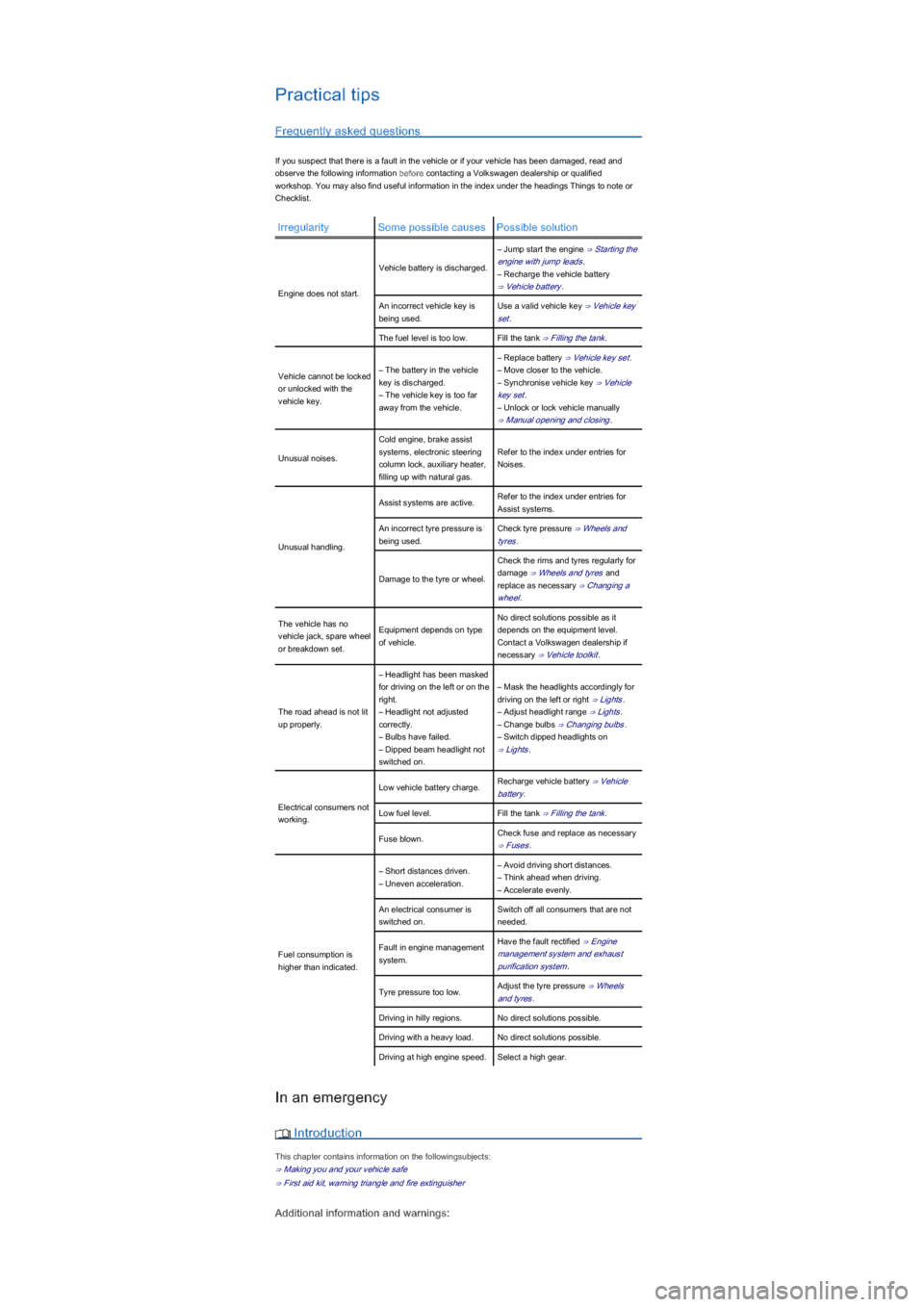
Practical tips
Frequently asked questions
If you suspect that there is a fault in the vehicle or if your vehicle has been damaged, read and
observe the following information before contacting a Volkswagen dealership or qualified
workshop. You may also find useful information in the index under the headings Things to note or
Checklist.
IrregularitySome possible causesPossible solution
Engine does not start.
Vehicle battery is discharged.
– Jump start the engine ⇒ Starting the
engine with jump leads.
– Recharge the vehicle battery
⇒ Vehicle battery.
An incorrect vehicle key is
being used.
Use a valid vehicle key ⇒ Vehicle key
set.
The fuel level is too low.Fill the tank ⇒ Filling the tank.
Vehicle cannot be locked
or unlocked with the
vehicle key.
– The battery in the vehicle
key is discharged.
– The vehicle key is too far
away from the vehicle.
– Replace battery ⇒ Vehicle key set.
– Move closer to the vehicle.
– Synchronise vehicle key ⇒ Vehicle
key set.
– Unlock or lock vehicle manually
⇒ Manual opening and closing.
Unusual noises.
Cold engine, brake assist
systems, electronic steering
column lock, auxiliary heater,
filling up with natural gas.
Refer to the index under entries for
Noises.
Unusual handling.
Assist systems are active.Refer to the index under entries for
Assist systems.
An incorrect tyre pressure is
being used.
Check tyre pressure ⇒ Wheels and
tyres.
Damage to the tyre or wheel.
Check the rims and tyres regularly for
damage ⇒ Wheels and tyres and
replace as necessary ⇒ Changing a
wheel.
The vehicle has no
vehicle jack, spare wheel
or breakdown set.
Equipment depends on type
of vehicle.
No direct solutions possible as it
depends on the equipment level.
Contact a Volkswagen dealership if
necessary ⇒ Vehicle toolkit.
The road ahead is not lit
up properly.
– Headlight has been masked
for driving on the left or on the
right.
– Headlight not adjusted
correctly.
– Bulbs have failed.
– Dipped beam headlight not
switched on.
– Mask the headlights accordingly for
driving on the left or right ⇒ Lights.
– Adjust headlight range ⇒ Lights.
– Change bulbs ⇒ Changing bulbs.
– Switch dipped headlights on
⇒ Lights.
Electrical consumers not
working.
Low vehicle battery charge.Recharge vehicle battery ⇒ Vehicle
battery.
Low fuel level.Fill the tank ⇒ Filling the tank.
Fuse blown.Check fuse and replace as necessary
⇒ Fuses.
Fuel consumption is
higher than indicated.
– Short distances driven.
– Uneven acceleration.
– Avoid driving short distances.
– Think ahead when driving.
– Accelerate evenly.
An electrical consumer is
switched on.
Switch off all consumers that are not
needed.
Fault in engine management
system.
Have the fault rectified ⇒ Engine
management system and exhaust
purification system.
Tyre pressure too low.Adjust the tyre pressure ⇒ Wheels
and tyres.
Driving in hilly regions.No direct solutions possible.
Driving with a heavy load.No direct solutions possible.
Driving at high engine speed.Select a high gear.
In an emergency
Introduction
This chapter contains information on the followingsubjects:
⇒ Making you and your vehicle safe
⇒ First aid kit, warning triangle and fire extinguisher
Additional information and warnings:
Page 196 of 211
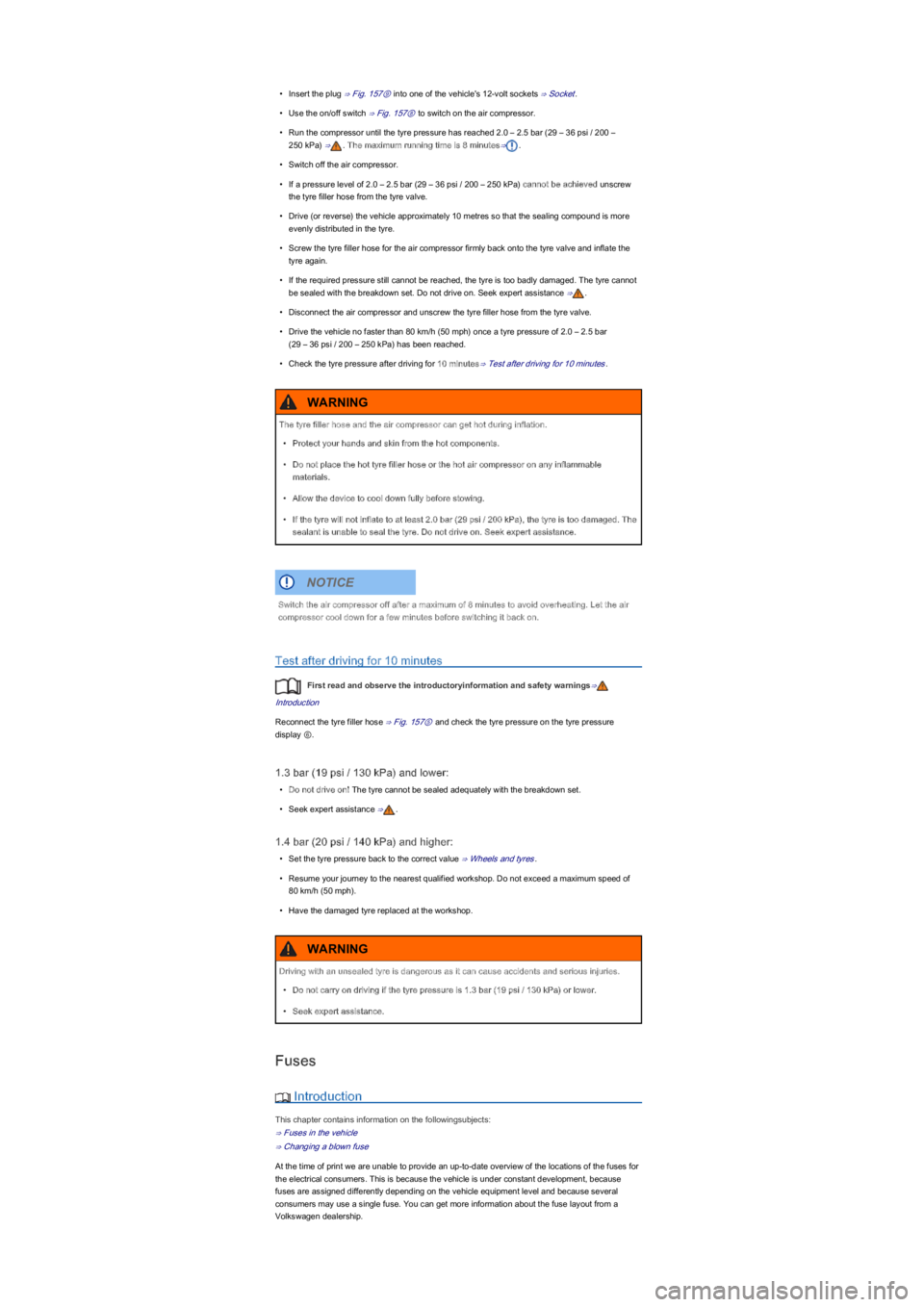
•Insert the plug ⇒ Fig. 157⑨ into one of the vehicle's 12-volt sockets ⇒ Socket.
•Use the on/off switch ⇒ Fig. 157⑧ to switch on the air compressor.
•Run the compressor until the tyre pressure has reached 2.0 – 2.5 bar (29 – 36 psi / 200 –
250 kPa) ⇒. The maximum running time is 8 minutes⇒.
•Switch off the air compressor.
•If a pressure level of 2.0 – 2.5 bar (29 – 36 psi / 200 – 250 kPa) cannot be achieved unscrew
the tyre filler hose from the tyre valve.
•Drive (or reverse) the vehicle approximately 10 metres so that the sealing compound is more
evenly distributed in the tyre.
•Screw the tyre filler hose for the air compressor firmly back onto the tyre valve and inflate the
tyre again.
•If the required pressure still cannot be reached, the tyre is too badly damaged. The tyre cannot
be sealed with the breakdown set. Do not drive on. Seek expert assistance ⇒.
•Disconnect the air compressor and unscrew the tyre filler hose from the tyre valve.
•Drive the vehicle no faster than 80 km/h (50 mph) once a tyre pressure of 2.0 – 2.5 bar
(29 – 36 psi / 200 – 250 kPa) has been reached.
•Check the tyre pressure after driving for 10 minutes⇒ Test after driving for 10 minutes.
Test after driving for 10 minutes
First read and observe the introductoryinformation and safety warnings⇒
Introduction
Reconnect the tyre filler hose ⇒ Fig. 157⑤ and check the tyre pressure on the tyre pressure
display ⑥.
1.3 bar (19 psi / 130 kPa) and lower:
•Do not drive on! The tyre cannot be sealed adequately with the breakdown set.
•Seek expert assistance ⇒.
1.4 bar (20 psi / 140 kPa) and higher:
•Set the tyre pressure back to the correct value ⇒ Wheels and tyres.
•Resume your journey to the nearest qualified workshop. Do not exceed a maximum speed of
80 km/h (50 mph).
•Have the damaged tyre replaced at the workshop.
Fuses
Introduction
This chapter contains information on the followingsubjects:
⇒ Fuses in the vehicle
⇒ Changing a blown fuse
At the time of print we are unable to provide an up-to-date overview of the locations of the fuses for
the electrical consumers. This is because the vehicle is under constant development, because
fuses are assigned differently depending on the vehicle equipment level and because several
consumers may use a single fuse. You can get more information about the fuse layout from a
Volkswagen dealership.
The tyre filler hose and the air compressor can get hot during inflation.
•Protect your hands and skin from the hot components.
•Do not place the hot tyre filler hose or the hot air compressor on any inflammable
materials.
•Allow the device to cool down fully before stowing.
•If the tyre will not inflate to at least 2.0 bar (29 psi / 200 kPa), the tyre is too damaged. The
sealant is unable to seal the tyre. Do not drive on. Seek expert assistance.
WARNING
Switch the air compressor off after a maximum of 8 minutes to avoid overheating. Let the air
compressor cool down for a few minutes before switching it back on.
NOTICE
Driving with an unsealed tyre is dangerous as it can cause accidents and serious injuries.
•Do not carry on driving if the tyre pressure is 1.3 bar (19 psi / 130 kPa) or lower.
•Seek expert assistance.
WARNING
Page 197 of 211
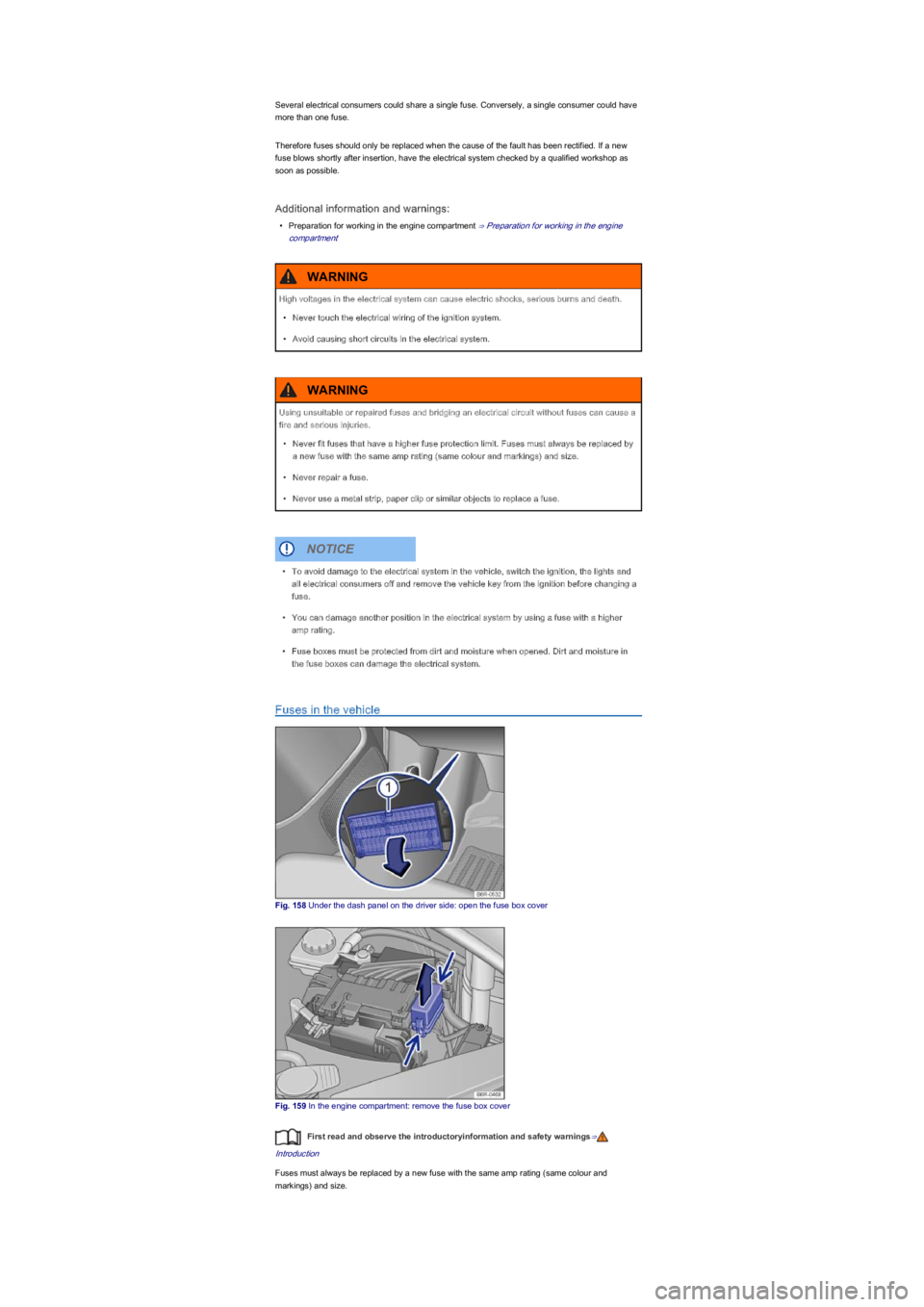
Several electrical consumers could share a single fuse. Conversely, a single consumer could have
more than one fuse.
Therefore fuses should only be replaced when the cause of the fault has been rectified. If a new
fuse blows shortly after insertion, have the electrical system checked by a qualified workshop as
soon as possible.
Additional information and warnings:
•Preparation for working in the engine compartment ⇒ Preparation for working in the engine
compartment
Fuses in the vehicle
Fig. 158 Under the dash panel on the driver side: open the fuse box cover
Fig. 159 In the engine compartment: remove the fuse box cover
First read and observe the introductoryinformation and safety warnings⇒
Introduction
Fuses must always be replaced by a new fuse with the same amp rating (same colour and
markings) and size.
High voltages in the electrical system can cause electric shocks, serious burns and death.
•Never touch the electrical wiring of the ignition system.
•Avoid causing short circuits in the electrical system.
WARNING
Using unsuitable or repaired fuses and bridging an electrical circuit without fuses can cause a
fire and serious injuries.
•Never fit fuses that have a higher fuse protection limit. Fuses must always be replaced by
a new fuse with the same amp rating (same colour and markings) and size.
•Never repair a fuse.
•Never use a metal strip, paper clip or similar objects to replace a fuse.
WARNING
•To avoid damage to the electrical system in the vehicle, switch the ignition, the lights and
all electrical consumers off and remove the vehicle key from the ignition before changing a
fuse.
•You can damage another position in the electrical system by using a fuse with a higher
amp rating.
•Fuse boxes must be protected from dirt and moisture when opened. Dirt and moisture in
the fuse boxes can damage the electrical system.
NOTICE
Page 198 of 211
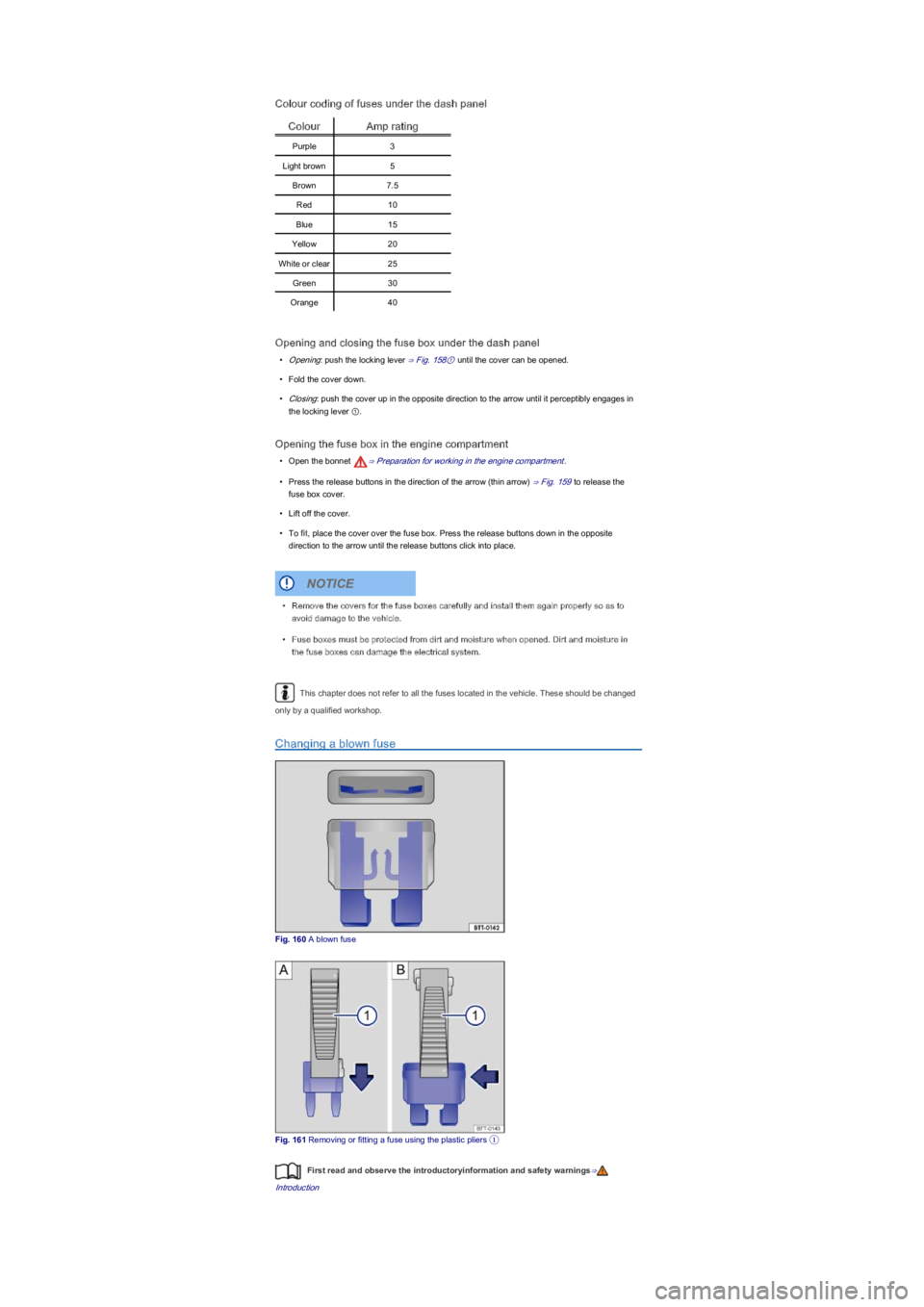
Colour coding of fuses under the dash panel
ColourAmp rating
Purple3
Light brown5
Brown7.5
Red10
Blue15
Yellow20
White or clear25
Green30
Orange40
Opening and closing the fuse box under the dash panel
•Opening: push the locking lever ⇒ Fig. 158① until the cover can be opened.
•Fold the cover down.
•Closing: push the cover up in the opposite direction to the arrow until it perceptibly engages in
the locking lever ①.
Opening the fuse box in the engine compartment
•Open the bonnet ⇒ Preparation for working in the engine compartment.
•Press the release buttons in the direction of the arrow (thin arrow) ⇒ Fig. 159 to release the
fuse box cover.
•Lift off the cover.
•To fit, place the cover over the fuse box. Press the release buttons down in the opposite
direction to the arrow until the release buttons click into place.
This chapter does not refer to all the fuses located in the vehicle. These should be changed
only by a qualified workshop.
Changing a blown fuse
Fig. 160 A blown fuse
Fig. 161 Removing or fitting a fuse using the plastic pliers ①
First read and observe the introductoryinformation and safety warnings⇒
Introduction
•Remove the covers for the fuse boxes carefully and install them again properly so as to
avoid damage to the vehicle.
•Fuse boxes must be protected from dirt and moisture when opened. Dirt and moisture in
the fuse boxes can damage the electrical system.
NOTICE
Page 199 of 211
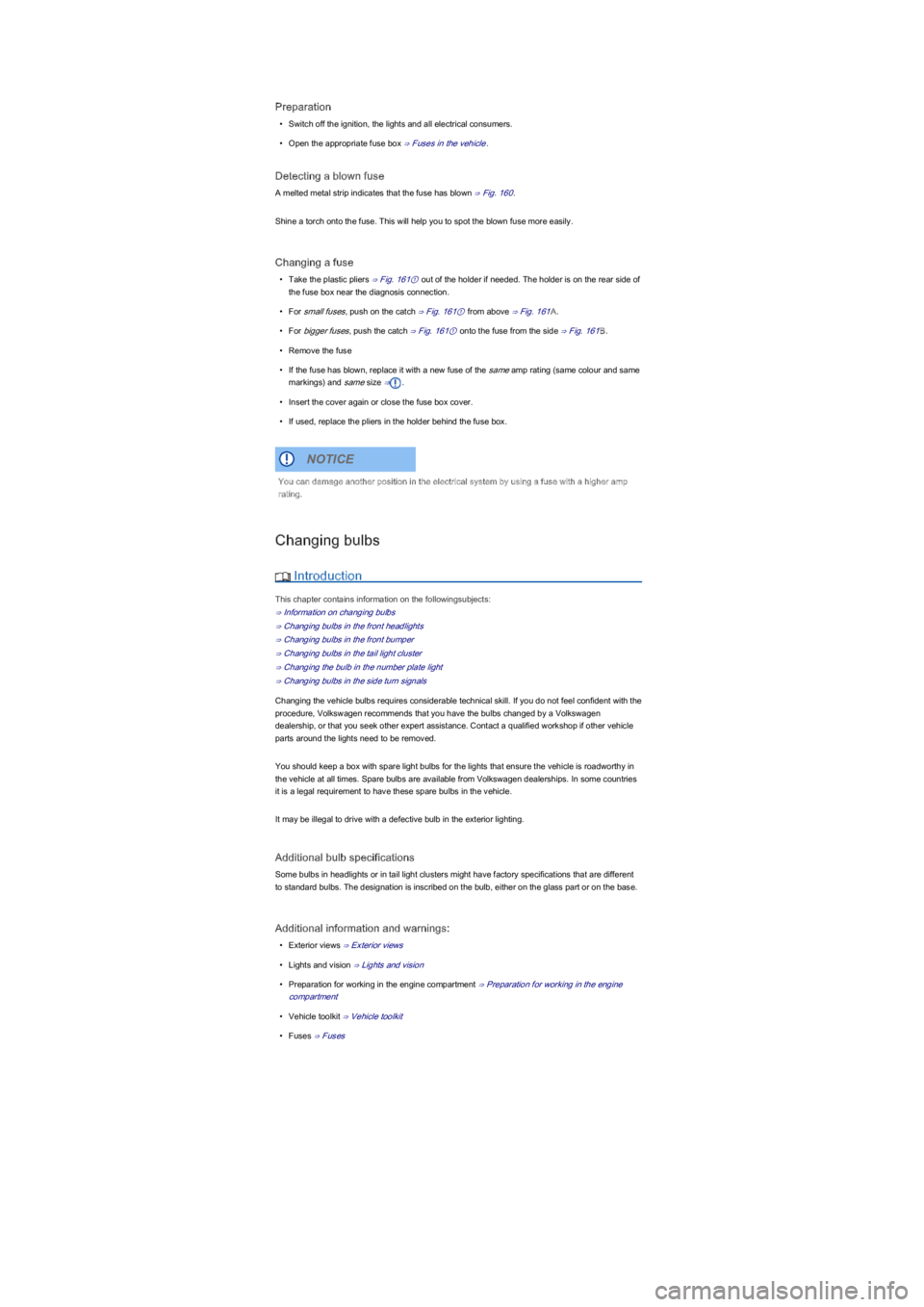
Preparation
•Switch off the ignition, the lights and all electrical consumers.
•Open the appropriate fuse box ⇒ Fuses in the vehicle.
Detecting a blown fuse
A melted metal strip indicates that the fuse has blown ⇒ Fig. 160.
Shine a torch onto the fuse. This will help you to spot the blown fuse more easily.
Changing a fuse
•Take the plastic pliers ⇒ Fig. 161① out of the holder if needed. The holder is on the rear side of
the fuse box near the diagnosis connection.
•For small fuses, push on the catch ⇒ Fig. 161① from above ⇒ Fig. 161A.
•For bigger fuses, push the catch ⇒ Fig. 161① onto the fuse from the side ⇒ Fig. 161B.
•Remove the fuse
•If the fuse has blown, replace it with a new fuse of the same amp rating (same colour and same
markings) and same size ⇒.
•Insert the cover again or close the fuse box cover.
•If used, replace the pliers in the holder behind the fuse box.
Changing bulbs
Introduction
This chapter contains information on the followingsubjects:
⇒ Information on changing bulbs
⇒ Changing bulbs in the front headlights
⇒ Changing bulbs in the front bumper
⇒ Changing bulbs in the tail light cluster
⇒ Changing the bulb in the number plate light
⇒ Changing bulbs in the side turn signals
Changing the vehicle bulbs requires considerable technical skill. If you do not feel confident with the
procedure, Volkswagen recommends that you have the bulbs changed by a Volkswagen
dealership, or that you seek other expert assistance. Contact a qualified workshop if other vehicle
parts around the lights need to be removed.
You should keep a box with spare light bulbs for the lights that ensure the vehicle is roadworthy in
the vehicle at all times. Spare bulbs are available from Volkswagen dealerships. In some countries
it is a legal requirement to have these spare bulbs in the vehicle.
It may be illegal to drive with a defective bulb in the exterior lighting.
Additional bulb specifications
Some bulbs in headlights or in tail light clusters might have factory specifications that are different
to standard bulbs. The designation is inscribed on the bulb, either on the glass part or on the base.
Additional information and warnings:
•Exterior views ⇒ Exterior views
•Lights and vision ⇒ Lights and vision
•Preparation for working in the engine compartment ⇒ Preparation for working in the engine
compartment
•Vehicle toolkit ⇒ Vehicle toolkit
•Fuses ⇒ Fuses
You can damage another position in the electrical system by using a fuse with a higher amp
rating.
NOTICE
Page 200 of 211
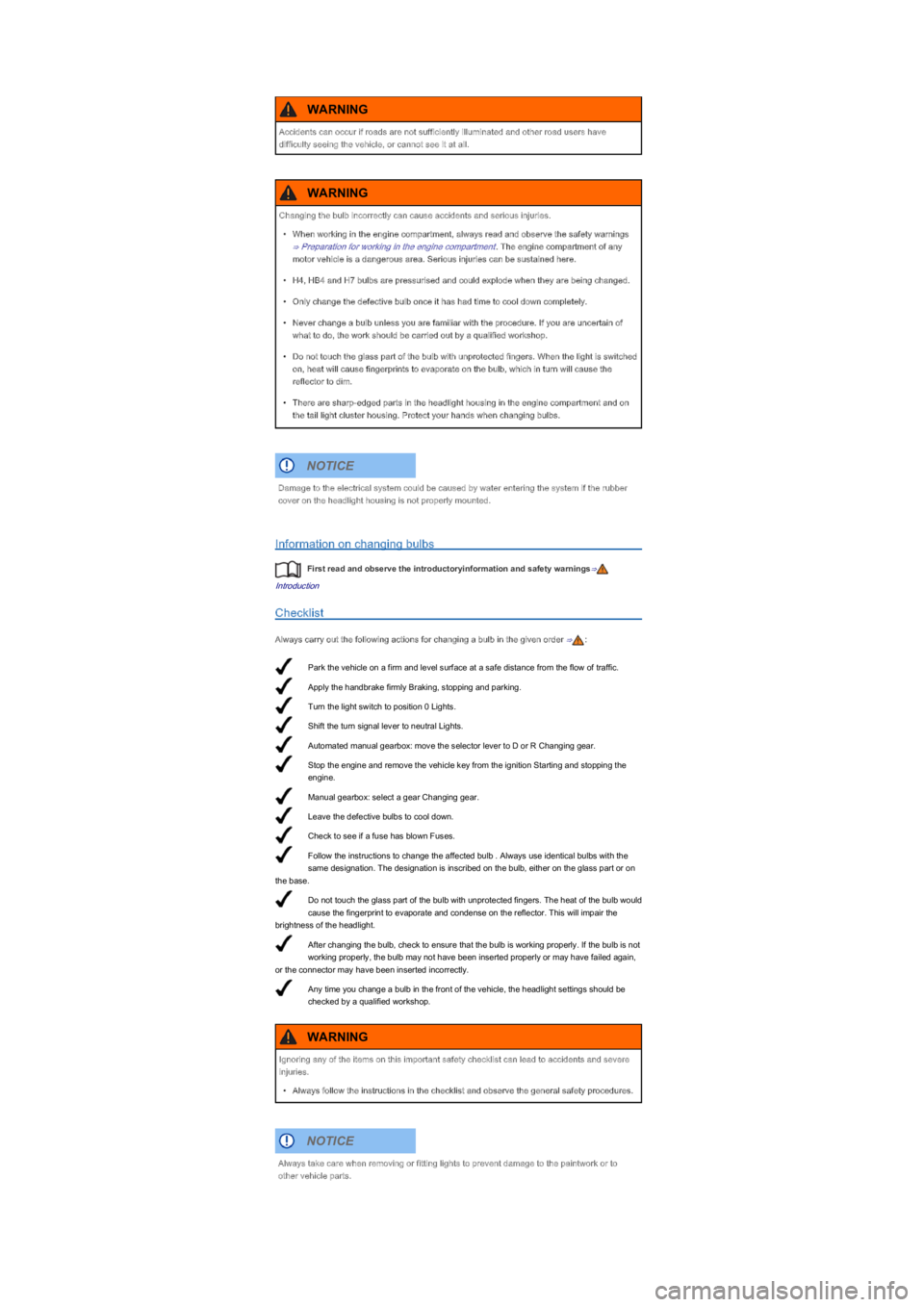
Park the vehicle on a firm and level surface at a safe distance from the flow of traffic.
Apply the handbrake firmly Braking, stopping and parking.
Turn the light switch to position 0 Lights.
Shift the turn signal lever to neutral Lights.
Automated manual gearbox: move the selector lever to D or R Changing gear.
Stop the engine and remove the vehicle key from the ignition Starting and stopping the
engine.
Manual gearbox: select a gear Changing gear.
Leave the defective bulbs to cool down.
Check to see if a fuse has blown Fuses.
Follow the instructions to change the affected bulb . Always use identical bulbs with the
same designation. The designation is inscribed on the bulb, either on the glass part or on
the base.
Do not touch the glass part of the bulb with unprotected fingers. The heat of the bulb would
cause the fingerprint to evaporate and condense on the reflector. This will impair the
brightness of the headlight.
After changing the bulb, check to ensure that the bulb is working properly. If the bulb is not
working properly, the bulb may not have been inserted properly or may have failed again,
or the connector may have been inserted incorrectly.
Any time you change a bulb in the front of the vehicle, the headlight settings should be
checked by a qualified workshop.
Information on changing bulbs
First read and observe the introductoryinformation and safety warnings⇒
Introduction
Checklist
Always carry out the following actions for changing a bulb in the given order ⇒:
Accidents can occur if roads are not sufficiently illuminated and other road users have
difficulty seeing the vehicle, or cannot see it at all.
WARNING
Changing the bulb incorrectly can cause accidents and serious injuries.
•When working in the engine compartment, always read and observe the safety warnings
⇒ Preparation for working in the engine compartment. The engine compartment of any
motor vehicle is a dangerous area. Serious injuries can be sustained here.
•H4, HB4 and H7 bulbs are pressurised and could explode when they are being changed.
•Only change the defective bulb once it has had time to cool down completely.
•Never change a bulb unless you are familiar with the procedure. If you are uncertain of
what to do, the work should be carried out by a qualified workshop.
•Do not touch the glass part of the bulb with unprotected fingers. When the light is switched
on, heat will cause fingerprints to evaporate on the bulb, which in turn will cause the
reflector to dim.
•There are sharp-edged parts in the headlight housing in the engine compartment and on
the tail light cluster housing. Protect your hands when changing bulbs.
WARNING
Damage to the electrical system could be caused by water entering the system if the rubber
cover on the headlight housing is not properly mounted.
NOTICE
Ignoring any of the items on this important safety checklist can lead to accidents and severe
injuries.
•Always follow the instructions in the checklist and observe the general safety procedures.
WARNING
Always take care when removing or fitting lights to prevent damage to the paintwork or to
other vehicle parts.
NOTICE